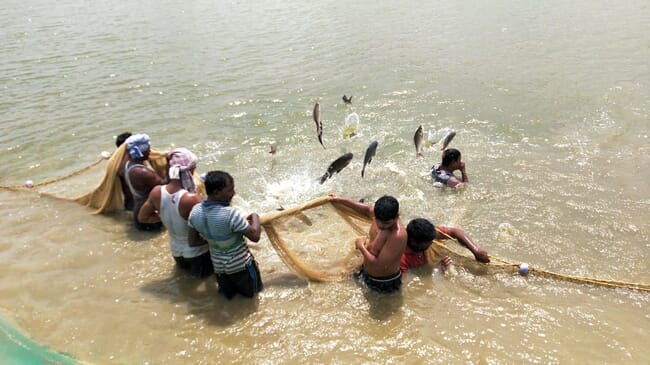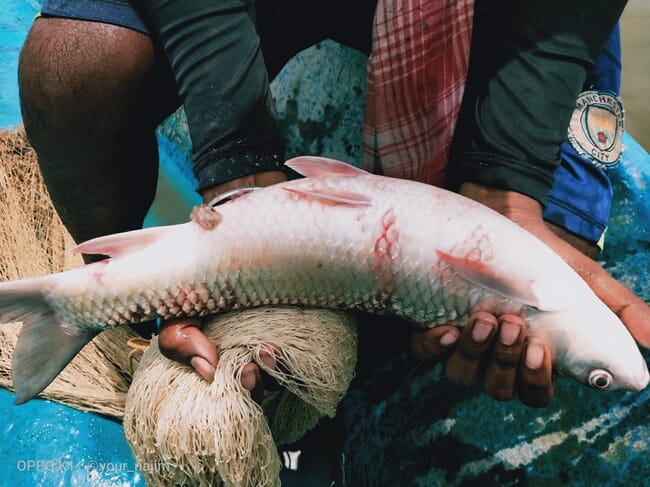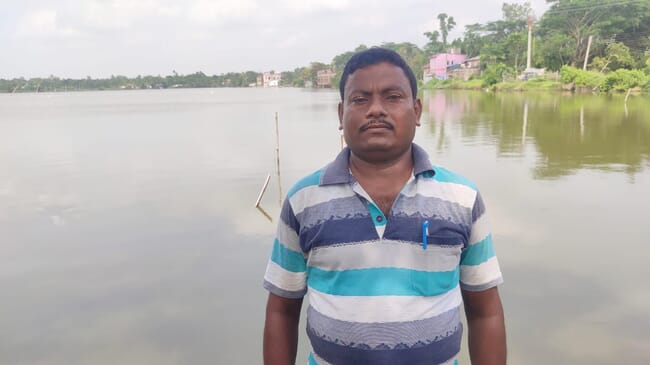
© Sk Najimuddin
Pradip Das is a fisherman from Moyna. The 50-year-old transformed his 150 acres of rice paddies into ponds for fish cultivation six years ago after hearing positive reports about the Moyna production model, a system that was named after his village. He thought the switch would help him to increase his income and sustain his family but now says that the fish farming system has not been as effective as was projected by the local administration and state government.
“Fish farming used to be done in small water bodies along with the paddy cultivation in Moyna. But increasing losses in paddy due to floods every year forced farmers to switch over to fish farming, which was a more profitable affair,” says Pradip.
What is the Moyna model?
The farmers living in Moyna have been combining fish farming with paddy cultivation for several decades. They utilised the small water bodies in the agricultural fields for growing indigenous species like tangra (black catfish), chital (clown knifefish) and tilapia.
However, by the late 1990s they realised that fish farming brought them five times more profit than rice paddies. The farmers then began organised rice/fish cultivation, where some quantities of Indian major carp and exotic carp fingerlings were released, followed by the application of supplementary fish feeds, which started producing better results and more profits.
Slowly, large number of farmers began to switch over to fish farming and started digging out their paddy fields so they could hold more fish. The system soon spread to all 11 villages in the Moyna community block, covering an estimated area of 7,500 hectares under 200 farms locally called as “Khope”, each ranging from 25 acres to 400 acres,

© Sk Najimuddin
“The Khope are then leased by a novel system, by which the owners, around 50-60 agricultural farmers, form a committee and the water body is then leased to the highest bidder for three to five years. The water bodies are dried, ploughed with tractors and then lime is applied,” says Abhishek Das, fishery extension officer for the Moyna development block.
“They are then filled with fresh water from a canal. Farmers then release 50g-100g fingerlings into the water at a density of 15,000-30,000 per hectare. The harvesting starts once the fish reach 500g, normally after three to four months. The fish are generally given organic feed such as rice bran. The farmers do not use many water conditioners or medicines. The buyers directly reach the village to buy fish,” he explains.
The Moyna model was typically adopted for water bodies of a minimum of 5 hectares and the river water was channelled into ponds for fish cultivation.
West Bengal decides to implement the model in other districts
Early success in Moyna made the West Bengal government decided to roll out the model as the state’s largest fisheries hub in 2017. The aim was not only to boost the aquaculture production sector but to also cut down the quantity of fish that Bengal imported from other states.
The government decided to bring water from the River Rupnarayan, which is located around 10km away from Moyna.
According to state government officials, the 7,000 hectares under the system have the potential to produce 60,000 to 70,000 tonnes of fish annually if the farming is carried out year-round – rather than the seven to eight months it is currently restricted to, due to water issues.
Describing the model as highly successful, the West Bengal government decided to replicate the model in other districts, but due to the lack of such large expanses of water in other places they had to make do with smaller bodies – even 2 hectare water bodies were used.
Farmers express unhappiness with the administration
Despite the much-hyped Moyna model earning accolades from the government, many of those using it paint a different picture; farmers claim that administrative ignorance and unfulfilled promises are leading to them losing money.
Over 150,000 farmers are involved in fishing in the Moyna block, spread across an area of 147km sq. The total area for fish production is around 7,000 hectares, while the remaining 500 hectares are used for prawn cultivation (fish cultivation is done in 4,465 ponds while prawn are cultivated in 929 ponds).

The total fish production in the Moyna area stands at around 84,000 tonnes, the bulk of it taking place between April and October, with an average production of around 12 tonnes per hectare. Some of the fish species that are cultured here include bhetki/barramundi (Lates calcarifer), tilapia (Oreochromis mossambica), magur (Clarias batrachus) and Indian minor carp (Labeo bata).
Farmers say that they are facing tough times, despite the government’s prase for the Moyna model.
“The government had assured us a year-round supply of fresh water by pipeline from the River Rupnarayan. But the project is still to be implemented. As a result, fields close to the river get water while others face water shortages that prevent us from fish farming year-round,” says Pradip, whose fields are located far from the river.
Farmers have also complained about diseases in the water.
“We face a severe shortage of water because of the lack of adequate water supply from the river,” says Amit Pramanik, 42, a fish farmer in Moyna. “The same water where fingerlings are released is transferred to other ponds. It affects the quality of water, leading to the spread of severe diseases in fish. I had to incur severe losses in the past two years because of the antibiotics in the water that killed huge amount of fish. We have now resorted to using organic feed like rice bran. No one from the administration has ever approached us to understand the situation. We are forced to fend for ourselves.”
Reduced quality
Farmers complain that the use of chicken waste, coupled with the overexploitation of groundwater, has wreaked havoc with production.
“Several farmers used chicken waste as food for the fish for several years, which reduced the quality of the fish taste. The fish no longer taste the same as before,” says Sanjay Das, 27, a local fish farmer. “The uncontrolled use of groundwater in farming and transportation of live fish has created severe water shortages. Fish were supplied to other parts of Bengal and even to the neighbouring states of Bihar and Jharkhand in packed containers with fresh water. But the depleting groundwater level has forced the government to put a ban on the use of submersible pumps for drawing groundwater, which has affected our business.”

© Gurvinder Singh
“We have been trying to create awareness of the use of organic feed supplement for fish farming,” says Sk Najimuddin, development officer of Zelence, a startup selling organic fish feeds to the farmers, “but it is very difficult to convince the farmers because they have been using the inorganic feed for a long time, as it is cheaper. But the excessive use of antibiotics and anti-parasite agents is not only harmful to the fish but also for human consumption.”
Apart from connecting Moyna with fresh river water, farmers demand that the government should set up a fully fledged laboratory and training centre for the fish farming community. They are also pressing for a chilling plant for fish storage and making ice available for fish transportation, as well as the extension of bank credit on favourable terms.
“The banks do not give loans to the farmers, as there are quite large number of defaulters. Besides, several youths have entered the trade which has led to an increase in competition. The marketing system needs an improvement for better connection between buyers and sellers,” points out Tuhin Hait, 47, a fish farmer in Moyna.
Conceding that farmers have been facing some issues, Das said their problems are being looked after by the government: “The water pipeline connection has been delayed due to the lockdown in the pandemic. It will resume soon. The farmers are being told to use organic feed for the fish but constant use of leather waste for the past several years has affected the fish quality and water. The use of groundwater has been stopped because of its severe shortage.”




